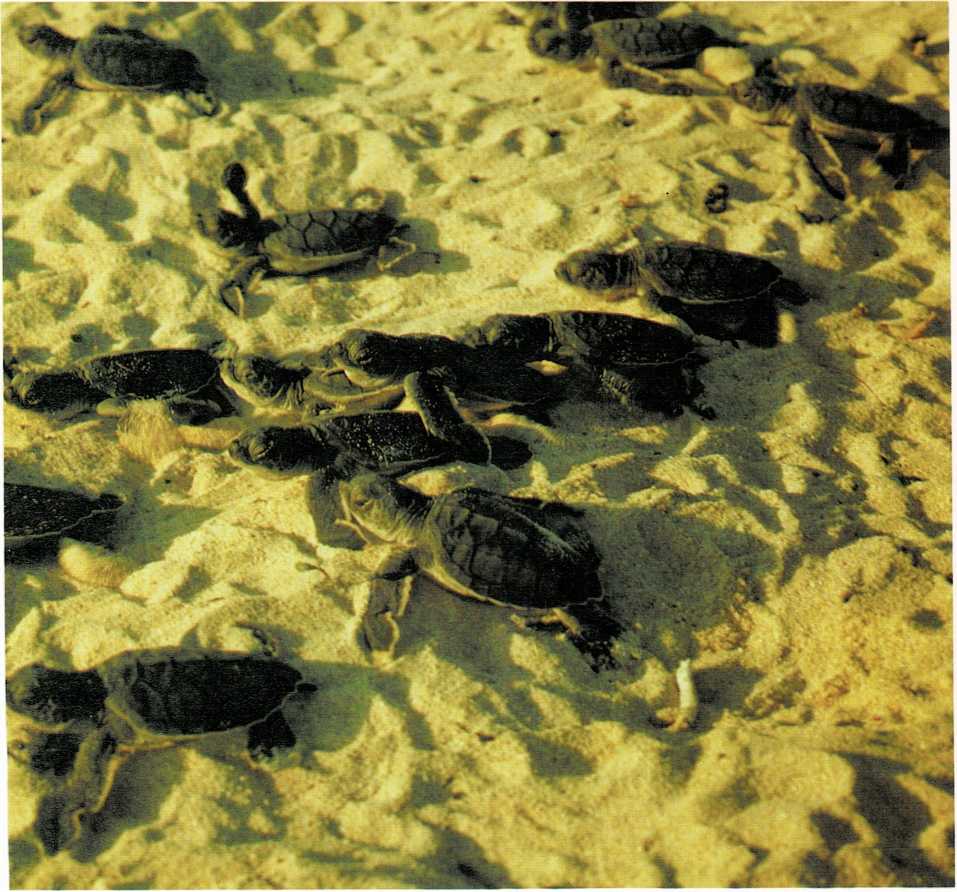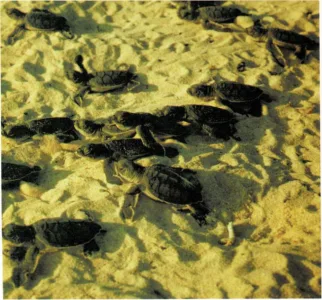Turtles of the sea
The biggest of all turtles makes its home in the sea. It’s called the
leatherback because its shell is covered by leathery black skin. A
full-grown leatherback may be more than six feet (1.8 meters) long and
weigh more than a thousand pounds (450 kilograms).
The leatherback is a marvelous swimmer. It seems to soar through the
water, flapping its long front flippers like wings. It eats fish, squid,
octopus, sea urchins, jellyfish, and some seaweed.
Leatherback turtles are a \”family” all by themselves. But there is
another family that contains a number of different kinds of sea turtles.
All the turtles of this family are quite large, but not as large as the
leatherback. And, unlike the leatherback, they all have shells that are
covered with a hard material instead of skin.
The biggest of these turtles is the green turtle. It may be more than
four feet (1.2 meters) long. It gets its name from the greenish color of
its fat. Green turtles eat mostly sea plants.
The loggerhead turtle is a bit more than three feet (1 meter) long. This
turtle eats mainly shrimps and crabs. The slightly smaller hawksbill
turtle has a beak like a hawk. It eats plants, sea urchins, and
jellyfish. Two other kinds of sea turtles are the Atlantic ridley and
the Pacific ridley. Each kind is about two feet (60 centimeters) in
length.
Sea turtles cannot pull their legs, head, and tail into their shell as
some kinds of freshwater turtles can. The males almost never come onto
land. And the females usually come onto land only to lay their eggs.
At egg-laying time, the females may swim for more than a thousand miles
(1,600 kilometers) to reach special beaches where they always lay their
eggs. Thousands of them come to the beaches at the same time.
newly hatched green turtles

They usually stay in the water near shore until night. Then, in the
darkness, they all move up onto the sand.
Their shells are so heavy out of water that the turtles have a difficult
time moving on land. They lift themselves up on their flippers and drag
themselves slowly along. When they stop to rest, they often give what
sounds like a deep, tired sigh!
Once they are past the part of the beach that is covered by high tide,
they begin to dig. Green turtles, loggerheads, and leatherbacks make
pits wide enough to hold their whole body. Then they dig a hole in the
bottom of the pit and lay their eggs in it. A green turtle lays about
one hundred eggs. Other kinds of sea turtles lay from fifty to two
hundred eggs.
When all the eggs are laid, the turtles cover them with sand. Then they
sweep sand about with their flippers to hide the nest from animals that
would dig up the eggs and eat them. At the first sign of daylight, the
turtles drag themselves slowly across the beach and back to the water.
The eggs hatch in about two or three months. The baby turtles push their
way up through the sand and scramble across the beach toward the water.
Often, there are thousands of baby turtles, all desperately flopping
toward the sea at the same time.
Many of them never get to the water. They are gobbled up by gulls,
terns, frigates, and other sea birds. And many that do get to the sea
are eaten by fish. Out of millions of baby turtles that hatch every
year, only a very few live to grow up!

